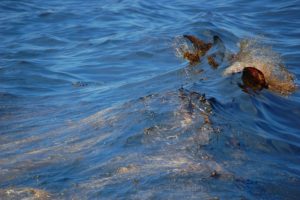
Photo credit: NOAA
By Brad Buck, public relations specialist at UF/IFAS Communications
PETERSBURG, Fla. — Nearly 10 years ago to the day, the Deepwater Horizon drilling rig began spilling millions of barrels of oil into the Gulf of Mexico. We know the Gulf is recovering, but it may be decades before science tells us the full impacts of the spill, a University of Florida expert says.
On the bright side, because of the all the data collection triggered by the oil spill, researchers know more about the Gulf of Mexico than they probably ever thought possible. Some of the evidence shows that, as an ecosystem, the Gulf is bouncing back.
“This new knowledge has allowed us to better understand how the Gulf works as a system and how this system may be impacted if a similar disaster happens again,” said Monica Wilson, a UF/IFAS Extension Florida Sea Grant agent based in St. Petersburg.
According to the EPA, on April 20, 2010, the Deepwater Horizon oil-drilling rig exploded and sank, resulting in the deaths of 11 workers and the largest man-made spill of oil in the history of marine oil drilling operations. Approximately 4 million barrels were released into the Gulf of Mexico, but a total of about 5 million barrels was released from the wellhead before it was capped on July 15.
Scientific data gathered in the 10 years since the oil spill shows that “the Gulf is a very complex system, and we are still not aware of all the long-term impacts,” Wilson said.
Wilson co-wrote a Q&A called Top 5 frequently asked questions about the Deepwater Horizon oil spill.
Top 5 frequently asked questions about the Deepwater Horizon oil spill
Here, Wilson provides concise responses to the questions that are answered in far more detail in the report:
- Is Gulf seafood safe to eat?
“Yes. Seafood testing confirmed years ago that oil chemicals found in seafood samples was well below the FDA’s level of concern.”
- What are the impacts to wildlife?
“The Gulf of Mexico contains many species. When oil enters an aquatic ecosystem, it could flow through the food web and impact entire populations and communities. Because of the complexity of the Gulf, it is difficult to predict the overall impacts. Different species were impacted in different ways.”
- Where did all the oil go and where is it now?
“During the initial spill, oil was found onshore, offshore and on the sea floor. Recent studies have found oil buried in deep-sea sediments. Oil that was buried on beaches may decompose over time or can resurface after storms.”
- What cleanup techniques were used and how were they implemented?
“Cleanup techniques included the use of skimmers to remove the oil from the sea’s surface. Fireproof boom was used to enclose surface oil and burn it. Dispersants were used at and below the water’s surface to break up the oil and keep large slicks from washing ashore.”
- Do dispersants make it unsafe for beachgoers to swim in the water?
“Dispersants cannot be applied within 3.45 miles from the shore by law. Due to the dispersant application being so far from the shore, no levels of the chemicals in dispersants were found in the water or were found in extremely low amounts. Research studies indicate that such low levels do not pose a threat to swimmers.”
For more information, contact Wilson at monicawilson447@ufl.edu.



